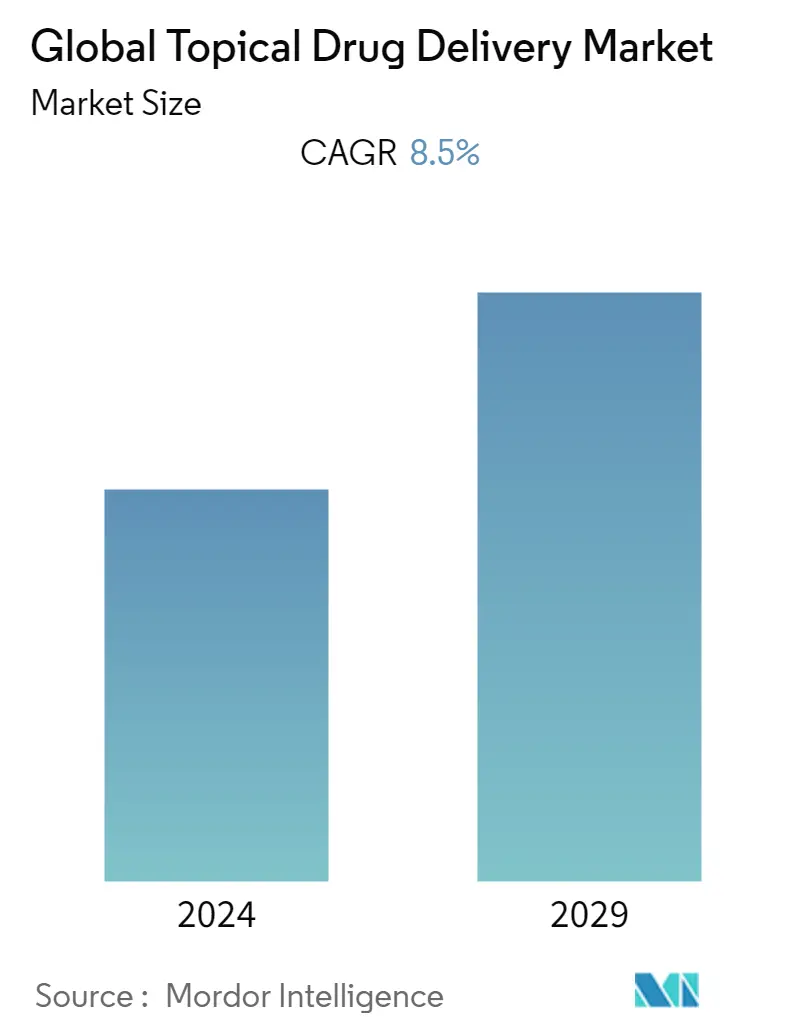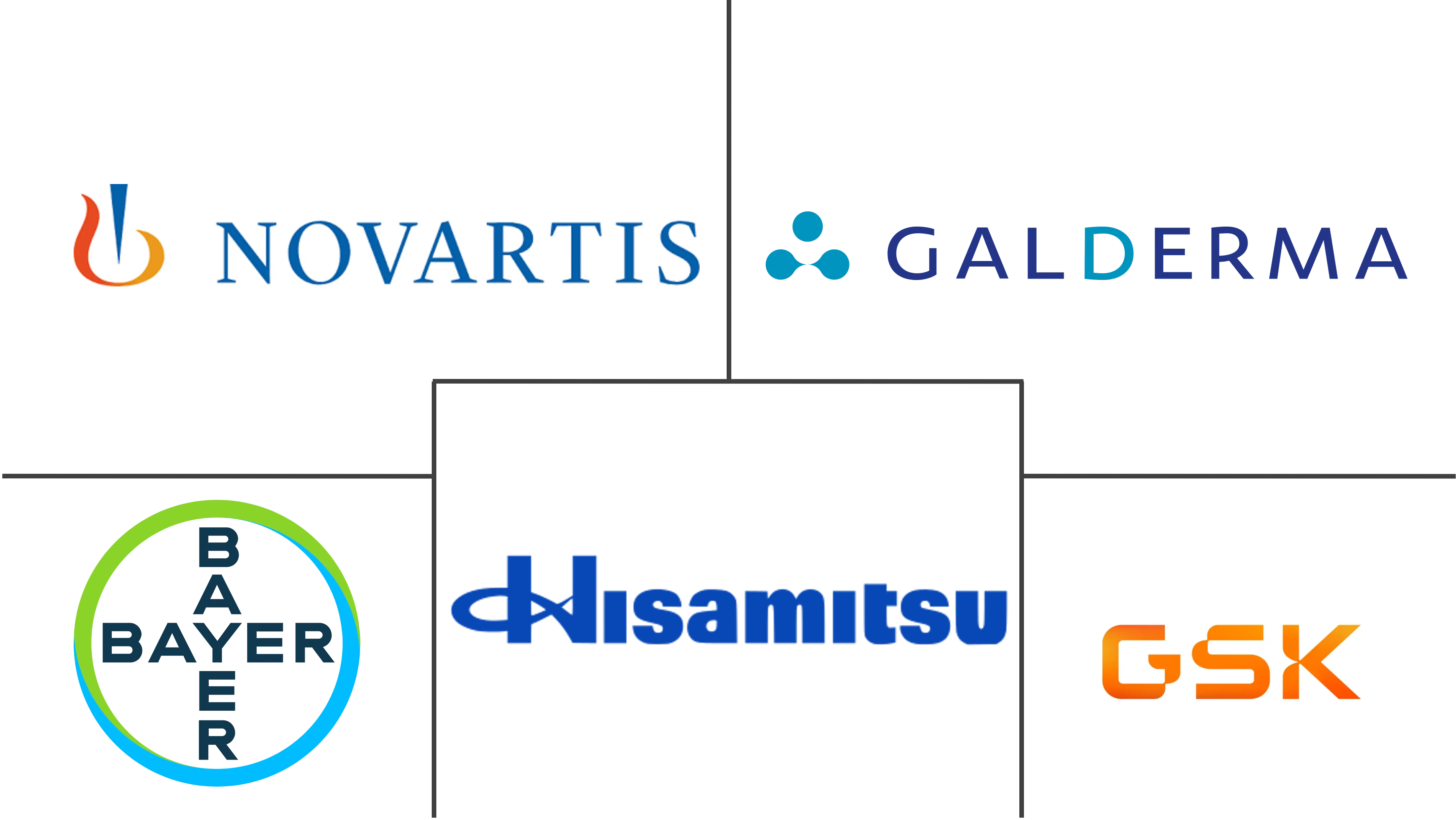Market Size of Global Topical Drug Delivery Industry

| Study Period | 2019 - 2029 |
| Base Year For Estimation | 2023 |
| Forecast Data Period | 2024 - 2029 |
| CAGR | 8.50 % |
| Fastest Growing Market | Asia Pacific |
| Largest Market | North America |
Major Players
*Disclaimer: Major Players sorted in no particular order |
Topical Drug Delivery Market Analysis
The Topical Drug Delivery Market is expected to witness a CAGR of 8.5% during the forecast period (2022 - 2027).
The COVID-19 pandemic has posed serious challenges to healthcare systems in Europe and has largely been controlled by drastically cutting down in- and outpatient services for diseases and implementing infection prevention and control measures. The lockdown all over the globe has affected the supply chain of drugs and products. The pandemic has significantly impacted the growth of the topical drug delivery market due to the pandemic situation and restrictions, healthcare settings such as hospitals and specialty clinics were temporary. For instance, an article published by the Dermatological Practical and Conceptual, in January 2021, titled 'Impact of the COVID-19 Pandemic on Dermatology Practice Worldwide: Results of a Survey Promoted by the International Dermoscopy Society (IDS)', it has been observed that the outbreak had a detrimental impact on the majority of dermatology services, leading to a considerable decrease in the amount of time spent consulting with patients and a higher likelihood of missed or delayed diagnoses of skin diseases. Thus, the decreased consulting time spent with patients resulted in a significant drop in patient visits, which has impacted the demand for treatment and services and has negatively impacted the market growth.
However, due to several disadvantages, such as discomfort and needle phobia, the requirement for two doses, the need for trained medical professionals to administer the vaccine, and barriers to international distribution due to the requirement for a cold supply chain, the demand for the transdermal delivery has increased. For instance, according to an article published by SAGE Journal, in August 2021, titled 'Transdermal approaches to vaccinations in the COVID-19 pandemic era', the potential of transdermal approaches, such as microneedle (MN) patches, as an alternative modality for painless medication delivery in COVID-19, has recently been explored. In addition, it has been observed that the successful development of microneedle (MN) patch vaccines has a substantial impact on future vaccine delivery and the decrease of the COVID-19 disease burden. Thus, the increasing clinical studies for topical delivery of vaccines in COVID-19 are expected to increase the market growth over the forecast period.
Certain factors that are propelling the market growth are the high prevalence of skin diseases and technological advancements and innovations.
The rising prevalence of skin diseases such as eczema, psoriasis, acne, cold sore, hives, eczema, and others are the key factors driving the market growth. For instance, according to an article published by StatPearls, in August 2021, titled 'Eczema', it has been observed that the lifetime prevalence of eczema in children is between 15-30% and 2-10% in adults. In addition, as per the same source, about 50% of the patients with severe atopic dermatitis are likely to develop asthma and 75% are likely to develop allergic rhinitis. Additionally, an article published by the Journal of the European Academy of Dermatology and Venerology, in February 2022, titled 'Incidence, prevalence, and risk of acne in adolescent and adult patients with atopic dermatitis: a matched cohort study', it has been observed that in both the general population and atopic dermatitis patients, the 12-month prevalence of acne was 3.7% and 3.9%, respectively. Also, the highest incidence rate of acne was found in atopic dermatitis patients aged 12-18 years, and women with atopic dermatitis had a somewhat greater incidence of acne than men. Furthermore, as per the same source, in comparison to controls, the risk ratio for acne rose with age, reaching 1.41 for patients between the ages of 30 and 39 and 2.07 for patients above the age of 40. Thus, the rising burden of skin diseases among the population is expected to increase the demand for effective and better treatment options which in turn is expected to increase the demand for topical agents, thereby boosting the market growth.
Additionally, the rising technological advancements and innovations are also contributing to market growth. For instance, in March 2022, Galderma launched Twyneo (fixed-dose combination of tretinoin 0.1% and benzoyl peroxide 3%) cream for the topical treatment of acne vulgaris in patients 9 years of age and older. Also, in December 2020, the United States Food and Drug Administration approved Almirall's Klisyri (tirbanibulin) for the topical treatment of actinic keratosis (AK) of the face or scalp.
However, the regulatory scenarios and pricing pressure, and high frequency of product recalls are some factors that are hindering the market growth over the forecast period.
Topical Drug Delivery Industry Segmentation
As per the scope of the report, topical drug delivery is a medication that is topically applied to a particular place or on the body. Topical drug delivery systems are preferably used to treat common skin diseases such as bacterial infections, fungal infections, inflammations, acne, psoriasis, hair, and skin problems. The Topical Drug Delivery Market is Segmented by Route of Administration (Dermal, Ophthalmic, Nasal, Oral, and Others), Product (Formulation and Device), and Geography (North America, Europe, Asia-Pacific, Middle East, and Africa, and South America. The market report also covers the estimated market sizes and trends for 17 different countries across major regions globally. The report offers the value (in USD million) for the above segments.
| By Route of Administration | |
| Dermal | |
| Ophthalmic | |
| Nasal | |
| Oral | |
| Others |
| By Product | |||||||||
| |||||||||
|
| By Geography | ||||||||
| ||||||||
| ||||||||
| ||||||||
| ||||||||
|
Global Topical Drug Delivery Market Size Summary
The topical drug delivery market is poised for significant growth, driven by the increasing prevalence of skin diseases and advancements in technology. The market is experiencing a shift towards transdermal delivery methods, such as microneedle patches, which offer advantages over traditional methods like injections, including reduced discomfort and improved patient compliance. The COVID-19 pandemic has further accelerated interest in these methods due to challenges associated with vaccine distribution and administration. Despite the pandemic's initial negative impact on healthcare services and supply chains, it has spurred innovation and clinical studies in topical vaccine delivery, contributing to market expansion. The rising incidence of conditions like eczema, psoriasis, and acne is fueling demand for effective topical treatments, while regulatory approvals and product launches are enhancing market offerings.
North America is expected to dominate the topical drug delivery market, supported by high healthcare spending and a growing focus on advanced treatment solutions. The region's increasing burden of skin diseases, coupled with rising healthcare investments, is driving the development and adoption of topical therapies. The market is characterized by moderate fragmentation, with key players such as Bayer AG, Cipla, and Galderma Holding SA actively participating in product development and approvals. The ongoing introduction of innovative products and the strategic expansion of companies in the region are anticipated to further propel market growth. As the demand for non-invasive and effective drug delivery methods continues to rise, the topical drug delivery market is set to experience robust growth over the forecast period.
Global Topical Drug Delivery Market Size - Table of Contents
-
1. MARKET DYNAMICS
-
1.1 Market Overview
-
1.2 Market Drivers
-
1.2.1 High Prevalence of Skin Diseases
-
1.2.2 Technological Advancements and Innovations
-
-
1.3 Market Restraints
-
1.3.1 Regulatory Scenario and Pricing Pressure
-
1.3.2 High Frequency of Product Recalls
-
-
1.4 Industry Attractiveness - Porter's Five Forces Analysis
-
1.4.1 Bargaining Power of Buyers/Consumers
-
1.4.2 Bargaining Power of Suppliers
-
1.4.3 Threat of New Entrants
-
1.4.4 Threat of Substitute Products
-
1.4.5 Intensity of Competitive Rivalry
-
-
-
2. MARKET SEGMENTATION (Market Size by Value in USD million)
-
2.1 By Route of Administration
-
2.1.1 Dermal
-
2.1.2 Ophthalmic
-
2.1.3 Nasal
-
2.1.4 Oral
-
2.1.5 Others
-
-
2.2 By Product
-
2.2.1 Formulation
-
2.2.1.1 Solid
-
2.2.1.2 Semi-Solid
-
2.2.1.2.1 Creams
-
2.2.1.2.2 Ointment
-
2.2.1.2.3 Others
-
-
2.2.1.3 Liquid
-
-
2.2.2 Device
-
2.2.2.1 Inhaler
-
2.2.2.2 Patch
-
-
-
2.3 By Geography
-
2.3.1 North America
-
2.3.1.1 United States
-
2.3.1.2 Canada
-
2.3.1.3 Mexico
-
-
2.3.2 Europe
-
2.3.2.1 Germany
-
2.3.2.2 United Kingdom
-
2.3.2.3 France
-
2.3.2.4 Italy
-
2.3.2.5 Spain
-
2.3.2.6 Rest of Europe
-
-
2.3.3 Asia Pacific
-
2.3.3.1 China
-
2.3.3.2 Japan
-
2.3.3.3 India
-
2.3.3.4 Australia
-
2.3.3.5 South Korea
-
2.3.3.6 Rest of Asia Pacific
-
-
2.3.4 Middle-East and Africa
-
2.3.4.1 GCC
-
2.3.4.2 South Africa
-
2.3.4.3 Rest of Middle-East and Africa
-
-
2.3.5 South America
-
2.3.5.1 Brazil
-
2.3.5.2 Argentina
-
2.3.5.3 Rest of South America
-
-
-
Global Topical Drug Delivery Market Size FAQs
What is the current Global Topical Drug Delivery Market size?
The Global Topical Drug Delivery Market is projected to register a CAGR of 8.5% during the forecast period (2024-2029)
Who are the key players in Global Topical Drug Delivery Market?
Hisamitsu Pharmaceuticals, Bayer AG, Novartis AG, Galderma Holding SA and GlaxoSmithKline PLC are the major companies operating in the Global Topical Drug Delivery Market.

